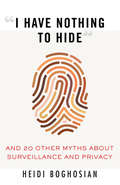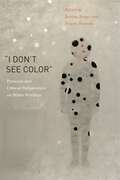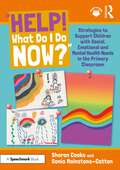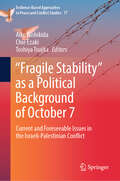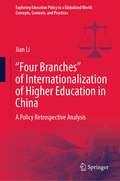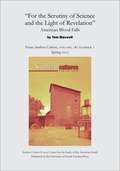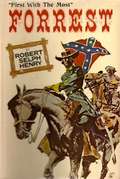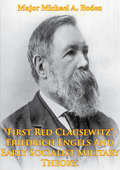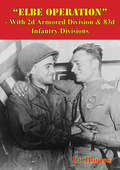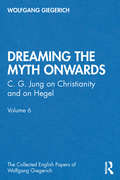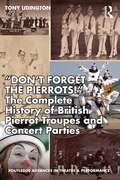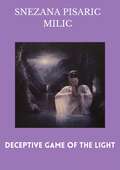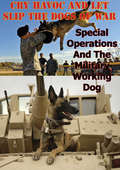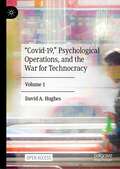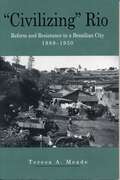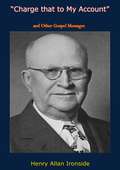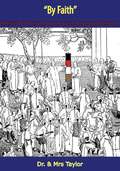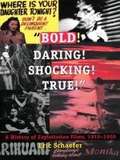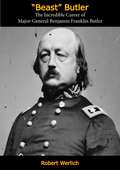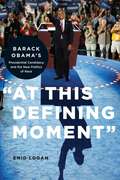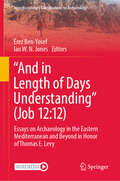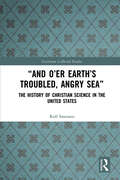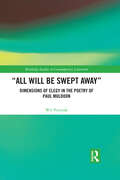- Table View
- List View
“I Have Nothing to Hide”: And 20 Other Myths About Surveillance and Privacy
by Heidi BoghosianAn accessible guide that breaks down the complex issues around mass surveillance and data privacy and explores the negative consequences it can have on individual citizens and their communities.No one is exempt from data mining: by owning a smartphone, or using social media or a credit card, we hand over private data to corporations and the government. We need to understand how surveillance and data collection operates in order to regain control over our digital freedoms—and our lives.Attorney and data privacy expert Heidi Boghosian unpacks widespread myths around the seemingly innocuous nature of surveillance, sets the record straight about what government agencies and corporations do with our personal data, and offers solutions to take back our information. &“I Have Nothing to Hide&” is both a necessary mass surveillance overview and a reference book. It addresses the misconceptions around tradeoffs between privacy and security, citizen spying, and the ability to design products with privacy protections. Boghosian breaks down misinformation surrounding 21 core myths about data privacy, including:● &“Surveillance makes the nation safer.&”● &“No one wants to spy on kids.&”● &“Police don&’t monitor social media.&”● &“Metadata doesn&’t reveal much about me.&”● &“Congress and the courts protect us from surveillance.&”● &“There&’s nothing I can do to stop surveillance.&”By dispelling myths related to surveillance, this book helps readers better understand what data is being collected, who is gathering it, how they&’re doing it, and why it matters.
“I Don’t See Color”: Personal and Critical Perspectives on White Privilege
by Bettina Bergo Eula Biss Tracey NichollsWho is white, and why should we care? There was a time when the immigrants of New York City’s Lower East Side—the Irish, the Poles, the Italians, the Russian Jews—were not white, but now “they” are. There was a time when the French-speaking working classes of Quebec were told to “speak white,” that is, to speak English. Whiteness is an allegorical category before it is demographic.This volume gathers together some of the most influential scholars of privilege and marginalization in philosophy, sociology, economics, psychology, literature, and history to examine the idea of whiteness. Drawing from their diverse racial backgrounds and national origins, these scholars weave their theoretical insights into essays critically informed by personal narrative. This approach, known as “braided narrative,” animates the work of award-winning author Eula Biss. Moved by Biss’s fresh and incisive analysis, the editors have assembled some of the most creative voices in this dialogue, coming together across the disciplines. Along with the editors, the contributors are Eduardo Bonilla-Silva, Nyla R. Branscombe, Drucilla Cornell, Lewis R. Gordon, Paget Henry, Ernest-Marie Mbonda, Peggy McIntosh, Mark McMorris, Marilyn Nissim-Sabat, Victor Ray, Lilia Moritz Schwarcz, Louise Seamster, Tracie L. Stewart, George Yancy, and Heidi A. Zetzer.
“Help! What Do I Do Now?”: Strategies to Support Children with Social, Emotional and Mental Health Needs in the Primary Classroom
by Sonia Mainstone-Cotton Sharon Cooke"Help! What Do I Do Now?" is an essential guide for primary school teachers, full of practical strategies to support children with social, emotional and mental health (SEMH) needs in the classroom.The book offers a comprehensive approach and holistic perspective on SEMH support, covering topics from regulating the whole class and regulating individual children, to understanding the impact of sensory needs and transitions. Chapters illustrate how a range of strategies can be applied in real-life classrooms, and case studies and reflections demonstrate how they can be adapted to suit each setting and unique child in need. Further support and guidance is also offered on staff wellbeing, emphasising the importance of looking after yourself and supporting your own wellbeing first.With a wealth of cost- and time-effective ideas and suggestions to support children with SEMH, this accessible guide will be essential reading for practising and trainee primary school teachers, as well as SENCOs and school leaders.
“Fragile Stability” as a Political Background of October 7: Current and Foreseeable Issues in the Israeli-Palestinian Conflict (Evidence-Based Approaches to Peace and Conflict Studies #17)
by Aiko Nishikida Chie Ezaki Toshiya TsujitaThis edited book aims to offer a comprehensive analysis of the preceding and ongoing development of the Israel-Gaza war, using a multidisciplinary approach. The chapters, written by scholars of the Middle Eastern studies, political science, anthropology, and international law, investigate the root causes of the eruption of the war, taking a viewpoint from within. Hamas&’s attack on Israel on October 7, 2023 caused deep shockwaves throughout the world. While the developments seemed unprecedented, the question remains whether it was an unpredictable total surprise. Given the context surrounding Palestine and Israel, it is likely that there were inherent elements in the preceding political environment that led to the current humanitarian disaster and quagmire of the battle. The assumption is that the existence of &“fragile stability&” might have caused the October 7 attack. What kind of fragility and robustness of the framework existed in the political, social, legal, and international conditions? How did these conditions affect the conduct of the actors in this region ultimately leading to the current situation? What challenges are likely to emerge in this region in the near future? This book addresses these questions from various perspectives. For the best clarification of the questions, authors include experts in American studies who discuss the diplomatic intervention of the United States, a former judge of the International Criminal Court who explores the role of international law in the conflict, and a legal advisor to the Oslo Peace Process who provides understanding the deep roots of the conflict. The analysis of this volume will provide an in-depth understanding of the background of the October 7 attack and contributes to the theoretical development of the concept of &“fragile stability,&” which can be applied to examine other cases of conflict. &“Fragile Stability provides a compelling and in-depth historical account of the background that proceeded Hamas&’ assault on October 7, 2023, and how it led to an unprecedented upsurge of violence in Gaza, one of the darkest moments in human history. A must-read for those who wish not only to understand the Palestinian-Israeli conflict but also to envision ways of resolving it.&” --- Sari Hanafi, Professor, American University of Beirut, Lebanon This topical edited volume includes a very important collection of essays addressing the political background and general context that led to the catastrophic Israel-Hamas War of 2023-2025, providing clues to make sense of the Hamas assault of October 7, 2023, followed by the Israeli military reaction in the Gaza Strip and the spread of the war in the region. Its unique contribution stems from different levels of analysis: several chapters refer to the domestic political landscapes in both Israel and Palestine, examining the numerous cleavages among and within both societies. In addition, the scope of the analysis broadens by referring also to international law and other relevant international actors, including the United States and Iran. --- Arie M. Kacowicz, Professor, Hebrew University of Jerusalem, Israel This volume showcases the critical insights and scholarship of Japanese scholars of the Middle East about the causes and consequences of the October 7 Hamas attack on Israel and the war which followed. With close studies of both Palestinian and Israeli politics, Fragile Stability makes a compelling case for an analytical framework which helps make sense of both dramatic changes and remarkable continuities in the conflict.
“Four Branches” of Internationalization of Higher Education in China: A Policy Retrospective Analysis (Exploring Education Policy in a Globalized World: Concepts, Contexts, and Practices)
by Jian LiThis book examines the emerging power of “Four Branches” of internationalization of higher education in China from a policy retrospective analysis. In particular, branch one includes China's policy on studying abroad after the reform and opening up; branch two concentrates on China's policy on studying in China after the reform and opening up; branch three explores the policy of Sino-foreign cooperation in running schools; branch four examines the policy of foreign exchange and cooperation. All these four emerging branches are interdependent, and all contribute to shaping the landscape of internationalization of higher education system in contemporary China. In addition, the conclusion and remarks are also offered in this book. The most important features of this book are: (1) new academic conceptualization; (2) comprehensive investigation of the new idea of “Four Branches” of internationalization of higher education in China from a policy retrospective analysis; (3) critically review and epitomize the contextualized construction of “Four Branches” of internationalization of higher education in China for constructing modern education model or system from conceptual, practical, and strategically scopes. The intended readers are scholars and researchers who are interested and work in research on China internationalization development in China and the administrators and stakeholders in Chinese education system and graduate students who majoring and minoring in the field of international education.
“For the Scrutiny of Science and the Light of Revelation”: American Blood Falls
by Tom MaxwellShowers of blood, however dreadful, were not news. Pliny, Cicero, Livy, and Plutarch mentioned rains of blood and flesh. Zeus makes it rain blood, 'as a portent of slaughter,' in Homer's Iliad."This article appears in the Spring 2012 issue of Southern Cultures. The full issue is also available as an ebook.Southern Cultures is published quarterly (spring, summer, fall, winter) by the University of North Carolina Press. The journal is sponsored by the University of North Carolina at Chapel Hill's Center for the Study of the American South.
“First With The Most” Forrest
by Robert Selph HenryNathan Bedford Forrest did not invent mobilized guerilla warfare, but he did modernize and polish it to an extent that has left few theoretical areas for improvement. Tanks and jeeps, it could even be said, do not possess the mobility relative to the main force which they attach that Forrest's dedicated band of horsemen enjoyed. Following in the footsteps of Francis Marion and Lighthorse Harry Lee, American practitioners of the devastating hit-and-run cavalry attach of the Revolutionary War, Forrest raised their effective but geographically limited campaigns to an art-form spread over the widest possible tactical theatre. He accomplished this with superior knowledge of terrain and of horses coupled and with an iron will, a complete disregard for physical exhaustion (his own and that of his men) and, this book will demonstrate, by the most admirable sort of sheer country orneriness.Forrest, a man of simple upbringing, is the perfect symbol for the odd mélange that was the Confederate Army; patrician West Pointers like Lee side by side by unregenerate racists like Forrest. These well-bred students of battles and from the classical era were not prevented by an almost unimaginable difference in class from being able to recognize the tactical genius of a farmer from the low country...That any scholar of this history of warfare would have to judge Forrest rather more harshly for his conduct after the war than this conduct during it is just another tragic aspect of the larger tragedy that generated The War Between the States. Heroes rose from unlikely places and returned, when the time for heroism had past, to their more unheroic pursuits. Whether than return negates the valor shown during the conflict is only for you to determine, after you have learned of Forrest's life in all its aspects, heroic, and less so.
“First Red Clausewitz”: Friedrich Engels And Early Socialist Military Theory
by Major Michael A. BodenBetween the European revolutions of the mid-nineteenth century and the Franco-Prussian War in 1870, Friedrich Engels functioned as a writer, analyst, and critic concerning military affairs. His most essential commentaries were published, disseminated, and internalized by supporters of the proletarian revolution. This project concentrates on the tactical, operational, and technical aspects of Engels' military thought and the development of his concepts from his earliest writings until the Franco-Prussian War. Historians and commentators routinely ignore these aspects of military theory in examinations of Engels' work. This project will demonstrate that Engels possessed are markable level of military knowledge and a degree of insight at the operational and tactical levels of warfare and that that he should be considered not only as an important social and economic thinker, but also among the most significant contributors to the field of nineteenth-and twentieth-century military history and theory. Engels' most significant contributions exist in the manner by which he, as a key member of the socialist leadership in the nineteenth century, integrated the concept of armed insurgency into the conduct of a proletarian revolution. By drawing on the experiences of the French Revolution and the wars of Napoleon, and then the impact of mass-industrialization, Engels was the first person to specifically incorporate a force dynamic into the trajectory of a socialist revolution. Despite the fact that he was a civilian with no formal military training beyond service as a Prussian artilleryman in 1842, his contributions to the field of revolutionary military theory earn him distinction as one of the most important socialist writers of the nineteenth century.
“Elbe Operation” - With 2d Armored Division & 83d Infantry Divisions
by Lt. HoucekThe crossing of the Elbe River was to prove a mortal blow to the hopes of the Nazi Command to continuing resistance to Allied forces in the West. The 2d Armored "Hell on Wheels" Division and 83d "Thunderbolt Division were the spearheads of the Ninth US army and they were the units who were first to seize the crossing of the Elbe. However the units were halted on orders from above and their advance was to be the furthest east the Allies reached during the hostilities and mark the point at which American and Russian Forces met for the first time. This short monograph produced by the European Theater of Operation historian Lt. Houcek was based on the oral testimony collected from the men involved.
“Dreaming the Myth Onwards”: C. G. Jung on Christianity and on Hegel, Volume 6 (The Collected English Papers of Wolfgang Giegerich)
by Wolfgang GiegerichThe fundamental importance of Christianity for Jung is well documented in his writings and letters. For the whole of his long career the great psychologist had wrestled with what he called " ... the great snake of the centuries. the burden of the human mind. the problem of Christianity." By comparison, his statements about Hegel are quite scarce. Both topics, nevertheless, have in common that they elicited from Jung radical accusations, accusations not presented in the calm tone of a psychological scholar but fired by a deep-seated personal affect that propelled Jung to wish "to dream the myth onwards," that is, to move to a new, his own improved and corrected version of Christianity. Rather than merely portraying and elucidating Jung’s views, this volume critically examines his theses and arguments by means of a series of close readings and by confronting his claims with the texts on which his interpretations are based. The guiding principle, in the spirit of which the author’s investigation is conducted, is the question of the needs of the soul and the standards of true psychology. While constantly bearing these needs and standards in mind, diverse topics are discussed in depth: Jung’s interpretation of a dream he had had about being unable to completely bow down before "the highest presence," his thesis concerning the patriarchal neglect of the feminine principle, his views about the alleged one-sidedness of Christianity, the "recalcitrant Fourth" and the "reality of Evil," his understanding of the Trinity and the spirit, his rejection of Hegel and of speculative thought, and his reaction to the modern "doubt that has killed" religious faith. A companion to the preceding volume, The Flight into the Unconscious, the essays collected here continue its radical critique of Jung’s psychology project, yielding not only deep insights into Jung’s personal religiosity and into what ultimately drove his psychology project as a whole, but granting as well a more sophisticated understanding of the psychological potential and telos of the Christian idea.
“Don’t Forget The Pierrots!'' The Complete History of British Pierrot Troupes & Concert Parties (Routledge Advances in Theatre & Performance Studies)
by Tony LidingtonThis volume is the first authoritative historical textbook to look at the origins, development and evolution of seaside pierrot troupes and concert parties and their popular performance heritage. It will provide, for the first time, a definition of the pierrot troupe and its evolution from the roots of European popular traditions such as the commedia dell’arte and minstrelsy, to links between music hall and contemporary popular culture. Tony Lidington will explore how pierrot troupes grew from a single idea into a major international cultural industry and how it boosted morale and national identity during the two World Wars, before sublimating into contemporary pop music and comedy. Tony’s continuing practice as research provides an experiential framework for the historical and ethnographic analysis of the form. This book will be of vital interest to students, researchers, and performers of outdoor (al fresco) arts, clowning and comedy, minstrelsy, vernacular music-making and music hall.
“Deceptive game of the light.”: SERBIAN (1 #1000)
by Snezana Pisaric MilicBook description: An exciting story about two women they talk about their fates. Six love stories in a novel. One woman is young, the other old. Events in the Balkans - Bosnia and Herzegovina, Croatia and Serbia. The love of Christians and Muslims. The war is over. Translation from Google Translate
“Dear Institute…”: Candid commentaries from candidates in psychoanalytic training
by Himanshu AgrawalThis book is a collection of commentaries by 40 psychoanalysts-in-training spanning across 29 different countries, shedding light on the state of contemporary psychoanalysis – its training, practice and relevance. The perception and landscape of typical psychoanalysis, the typical psychoanalyst and the typical psychoanalytic trainee have witnessed a tectonic shift since Dr. Sigmund Freud first introduced this technique over a hundred years ago. This book challenges and inspires us to think, at all levels, about reimagining how psychoanalysis should be taught in the 21st century. Inspired by Fred Busch’s Dear Candidate (Routledge, 2021), chapters are written in the style of personal letters from candidates to their faculty and institutes. Each contributor shares a piece of their mind – and their heart – about the trials and tribulations of the process of psychoanalytic training – what they cherished, what they loathed, why they spoke up and why they dropped out.This book is an important read for both prospective candidates as well as veteran psychoanalysts and institutional leaders.
“Dear Fatherland, Rest Quietly”: A Report on the Collapse of Hitler’s “Thousand Years”
by Margaret Bourke-WhiteTHIS IS the story of the search for “Faceless Fritz”—the most difficult and frightening camera-hunt ever undertaken by ace photographer-reporter Margaret Bourke-White. “Fearless Fritz” was cable shorthand for one of several LIFE assignments that brought Miss Bourke-White and her camera to Germany some months before its fall. She was to pin down the private German citizens—to find out what kind of human being it was who, multiplied by millions, made up the Nazi terror. Was he cruel? Was he a villain? Or was he a jolly, gemutlich, beer-drinking, music-loving sentimentalist so many of us remembered, who had really been helpless in the power of a small gang of madmen?By the time Margaret Bourke-White arrived in Germany on this mission, she had seen much death and danger. She had been in Moscow during its fiercest bombings. In Italy she had come closer to the enemy lines than any American woman before her. But it was in Germany that cold horror overtook her.The Germany that Miss Bourke-White saw and recorded in this book puts to shame Dali’s most grotesque nightmares. It is a physical and spiritual chamber of horrors, a cuckoo-cloud land whose inhabitants live in a lost dream. They are the people whose faces are as usual and recognizable as neighbors’, but whose reactions do not seem to make sense.“Dear Fatherland, Rest Quietly,” which was first published in 1946, takes its title from the words of the anthem, “Die Wacht am Rhein,” to which German soldiers have marched three times in the memory of many now living. It brings new light to bear on the German people—in the hope that through a more immediate understanding of them, a fourth march may be averted…Richly illustrated throughout with 128 of her photographs, with detailed captions, forming an integral part of Margaret Bourke-White’s important report on conquered Germany.
“Cry Havoc And Let Slip The Dogs Of War”. Special Operations And The Military Working Dog
by Major Joseph F. WhelanThis paper examines the potential for military working dogs to support Special Operations Forces (SOF). Modern technology has not eliminated the operational prospective for the military employment of dogs. Canine olfactory superiority, advanced hearing, and ability to detect movement offer significant military employment potential. Military working dogs can be trained for scouting, patrolling, building and ship searches, countermine, counterdrug and tracking. When used properly, dogs are an inexpensive and efficient force multiplier.Qualitative research using correlational data comprises the monograph's methodology. Military working dog capabilities, limitations, and historical employment will be discussed and then compared to Special Operation Forces principal missions and collateral activities.The conclusion demonstrates that dogs have a wider role to perform in today's operational environment and that military working dogs can augment and complement SOF operations. Nearly every SOF mission can benefit from the inclusion of dogs- particularly in support of Stability and Support Operations conducted in developing countries that cannot employ or sustain complex and technologically sophisticated equipment. Military working dogs are a proven, low technology, combat and combat support capability and may have a future role in support of Special Operations Forces.
“Covid-19,” Psychological Operations, and the War for Technocracy: Volume 1
by David A. HughesCamouflaged by “Covid-19,” an undeclared global class war was initiated in 2020, aimed at replacing liberal democracy with technocracy, a novel, biodigital form of totalitarianism. The opening campaign involved the largest psychological operation in history, intended to demoralise, disorientate, and debilitate the public. This volume deals with the application of shock and stress, trauma-based mind control, the use of fear and threat, cognitive attack, weaponised deception, and techniques for turning society against itself. This is an open access book.
“Civilizing” Rio: Reform and Resistance in a Brazilian City, 1889–1930
by Teresa MeadeA massive urban renewal and public-health campaign in the first decades of the nineteenth century transformed Brazil's capital into a showcase of European architecture and public works. The renovation of Rio, or "civilization" campaign, as the government called it, widened streets, modernized the port, and improved sanitation, lighting, and public transportation. These changes made life worse, not better, for the majority of the city's residents, however; the laboring poor could no longer afford to live in the downtown, and the public-health plan did not extend to the peripheral areas where they were being forced to move. Their resistance is the focus of Teresa Meade's study.Meade details how Rio grew according to the requirements of international capital, which financed, planned, and oversaw the renewal—and how local movements resisted these powerful, distant forces. She also traces the popular rebellion that continued for more than twenty years after the renovation ended in 1909, illustrating that community protests are the major characteristic of political life in the modern era.
“Charge that to My Account” and Other Gospel Messages
by Henry IronsideBecause GOD has been pleased to set His seal of approval upon these simple gospel messages by using them in the awakening and salvation of sinners, they can be found here, in book form, in the earnest hope that many who read them may find joy and peace in believing!First published in 1931, Pastor H. A. Ironside’s “Charge that to My Account” and Other Gospel Messages contains 12 interesting studies, beginning with his best known gospel presentation based on Paul’s letter to Philemon, and includes “Will a Loving God Permit Anyone to Be Eternally Lost?” and “Inside the Veil, Outside the Camp.”
“By Faith”: Henry W. Frost and the China Inland Mission
by Dr Howard Taylor Geraldine TaylorBy inspired definition faith is ‘being sure of what we hope for and certain of what we do not see.” By faith we are saved. By faith we are justified. By faith we please God. Though faith is central in the Christian life, we somehow are amazed when we see the vitality and power of faith at work in ordinary people’s lives. In each generation we see a special few men and women who have stretched themselves by risking everything on the sure promises of God. In the end they prove the faithfulness of their Master and challenge their own day to take their God seriously. Their stories are an encouragement to the next generation as they in turn join the ranks of that “great cloud of witnesses” who cheer us on in the life of faith.Henry W. Frost bore eloquent testimony to his generation that God was willing to bear the responsibility for a surrendered life. What Hudson Taylor was to England, Henry Frost was to North America. His strength of faith and character gave stability to the fledgling North American branch of the China Inland Mission.It has been said that courage is the power to let go of the familiar. If that is the case, the life of Henry Frost and his leadership of the North American China Inland Mission will be the most courageous biography you have ever read.
“Bold! Daring! Shocking! True!”: A History of Exploitation Films, 1919-1959
by Eric SchaeferUnashamed nudists, high-flying hopheads, brazen strippers, vicious vice lords, and high school girls who find themselves "in trouble" comprise the population of exploitation films. In the first full-scale history of these low-budget movies of decades past, Eric Schaefer reveals how this pioneering form of "trash film" purveyed the forbidden thrills of explicit sexual behavior, drug use, and vice that the mainstream movie industry could not show. Bold! Daring! Shocking! True! is a meticulously researched, interdisciplinary study that is informed by a wide range of sources--including both mainstream and industry newspapers and periodicals, archival accounts, personal interviews, and the films themselves. Schaefer begins by exploring the unique mode of production of exploitation movies, their distribution, and the outrageous exhibition practices that were rooted in the traditions of sideshows and carnivals. His close analysis of dozens of films, such as The Road to Ruin, Modern Motherhood, One Way Ticket to Hell, and The Wages of Sin demonstrates that these films were more than simply "bad" movies. By situating exploitation films in a historical context and organizing them according to the social problems they addressed, Schaefer shows how they evolved during a period of forty years and how, during that time, they shaped public policies and attitudes. Finally, he focuses on the changes in the postwar American film industry that led to the decline of the classical exploitation film and set the stage for the rise of "sexploitation" in the 1960s. Engagingly written, illustrated with rare photographs, posters, production stills, and ad slicks, and offering a full filmography, Bold! Daring! Shocking! True! reveals a forgotten side of film history and American culture. It will delight and inform those interested in film history, cultural studies, American studies and history, and the many fans of exploitation films.
“Beast” Butler: The Incredible Career of Major-General Benjamin Franklin Butler
by Robert WerlichFirst published in 1962, this is a biography of Benjamin Franklin Butler, (1818-1893), aka “Beast” Butler, an American lawyer, politician, soldier and businessman from Massachusetts, who became best known as a political major general of the Union Army during the American Civil War, and for his leadership role in the impeachment of President Andrew Johnson. He was a colorful and often controversial figure on the national stage and in the Massachusetts political scene, where he served one term as Governor.“In the history of the United States, there has never been anyone quite like Benjamin Franklin Butler. Without a doubt one of the most incompetent Generals and corrupt politicians this nation has ever seen, Butler was accused during the Civil War, of murder, trading with the enemy, theft, maltreatment of women, blackmail, and arson. He was the only Union General that the Confederacy ordered hanged on the spot if captured.With his malefactions public knowledge, he became after the War, successively five times Republican United States Congressman, Democratic Governor of Massachusetts, and Greenback-Peoples candidate for the Presidency. He achieved these high positions by sheer bluff, taking care of his supporters, and by an oratorical ability to twist any occurrence, no matter how incredible, stupid, or shady into a vindication of himself. He was a demagogue’s demagogue.”—Robert Werlich, Foreword
“At This Defining Moment”: Barack Obama’s Presidential Candidacy and the New Politics of Race
by Enid Lynette LoganIn January 2009, Barack Obama became the 44th president of the United States. In the weeks and months following the election, as in those that preceded it, countless social observers from across the ideological spectrum commented upon the cultural, social and political significance of “the Obama phenomenon.” In “At this Defining Moment,” Enid Logan provides a nuanced analysis framed by innovative theoretical insights to explore how Barack Obama’s presidential candidacy both reflected and shaped the dynamics of race in the contemporary United States. Using the 2008 election as a case study of U.S. race relations, and based on a wealth of empirical data that includes an analysis of over 1,500 newspaper articles, blog postings, and other forms of public speech collected over a 3 year period, Logan claims that while race played a central role in the 2008 election, it was in several respects different from the past. Logan ultimately concludes that while the selection of an individual African American man as president does not mean that racism is dead in the contemporary United States, we must also think creatively and expansively about what the election does mean for the nation and for the evolving contours of race in the 21st century.
“And in Length of Days Understanding”: Essays on Archaeology in the Eastern Mediterranean and Beyond in Honor of Thomas E. Levy (Interdisciplinary Contributions to Archaeology)
by Ian W. N. Jones Erez Ben-YosefThis two-volume book presents cutting-edge archaeological research, primarily as practiced in the Eastern Mediterranean region. These volumes’ key foci are inspired by the work of Thomas E. Levy. Volume 1 provides an in-depth look at new archaeological research in the southern Levant (primarily in modern Israel and Jordan) inspired by Levy’s commitment to understanding social, political, and economic processes in a long-term or “deep time” perspective. Volume 2 focuses on new research in several key areas of 21st century anthropological archaeology and archaeological science. Volume 1 is organized around two major themes: 1) the later prehistory of the southern Levant, or the Neolithic, Chalcolithic, and Bronze Age, and 2) new research in biblical archaeology, or the historical archaeology of the Iron Age. Each section contains a combination of new perspectives on key debates and studies introducing new research questions and directions. Volume 2 is organized around five major themes: 1) the archaeology of the Faynan copper ore district of southern Jordan, a key region for archaeometallurgical research in West Asia where Levy conducted field research for over a decade, 2) new research in archaeometallurgy beyond the Faynan region, 3) marine and maritime archaeology, focusing on issues of trade and environmental change, 4) cyber-archaeology, an important 21st century field Levy conceived as “the marriage of archaeology, engineering, computer science, and the natural sciences,” and 5) key issues in anthropological archaeological theory. In addition to presenting the reader with an up-to-date view of research in each of these areas, the volume also has chapters exploring the connections between these themes, e.g. the maritime trade of metals and cyber-/digital archaeological approaches to metallurgy. The work contains contributions from both up-and-coming early career researchers and key established figures in their fields. This book is an essential reference for archaeologists and scholars in related disciplines working in the southern Levant and the Eastern Mediterranean.
“And O’er Earth’s Troubled, Angry Sea”: The History of Christian Science in the United States (Variorum Collected Studies)
by Rolf SwensenChristian Science is one of the most unique and controversial of American religions, but there has never been a history of this influential metaphysical group, best known for its healing through prayer. Most attention has previously focused on the church’s founder, Mary Baker Eddy (1821-1910). This compilation of nine previously published scholarly articles, buttressed by additional insight presented in the preface, introduction, and conclusion, should lead to further investigation of this compelling topic.This volume investigates the origins of the Christian Science movement, illustrates how Eddy’s students -- mainly women -- helped its rapid spread through healings, how Eddy guided and restrained her students, examines some denominational growing pains, underscores how The Mother Church in Boston and Eddy’s Church Manual evolved, recounts dozens of testimonies of healing, and shows how local, or branch, churches operated before and after Eddy’s passing. Contrary to previous assumptions, the new Christian religion was surprisingly diverse, with almost one half of the membership coming from the lower middle and working classes. This vibrant church ultimately declined, due to excessive centralization and insufficient utilization of the membership, plus lack of social activities and the rise of medical science. Recent efforts to revitalize the movement through embracing communities are continuing.“And O’er Earth’s Troubled, Angry Sea”: The History of Christian Science in the United States will appeal to Christian Scientists, kindred spirits in the metaphysical world, anyone interested in religion, and those who read social history. Each chapter is suitable for group discussions and for undergraduate or graduate classes.
“All Will Be Swept Away”: Dimensions of Elegy in the Poetry of Paul Muldoon (Routledge Studies in Contemporary Literature)
by Wit PietrzakThe book offers the first comprehensive study of Paul Muldoon’s mourning verse. Considering not only the celebrated elegies like "Yarrow," "Incantata" or "Sillyhow Stride" but also the elegiac impulse as it develops throughout Muldoon’s entire work, All Will Be Swept Away charts a large swathe of Muldoon’s poetic landscape in order to show the complexity with which he approaches the themes of death and mourning. Using archival material as well as a vast array of theoretical apparatuses, the book unveils the psychological, literary and political undertones in his poetry, all the while attending to the operations of the poetic text: its form, its music and its capacity to console, warn and censure.
